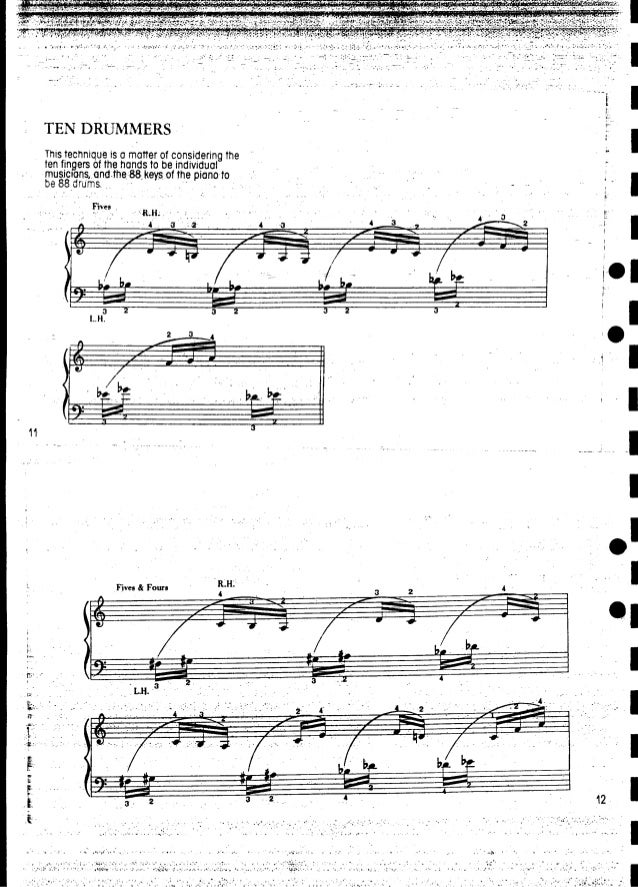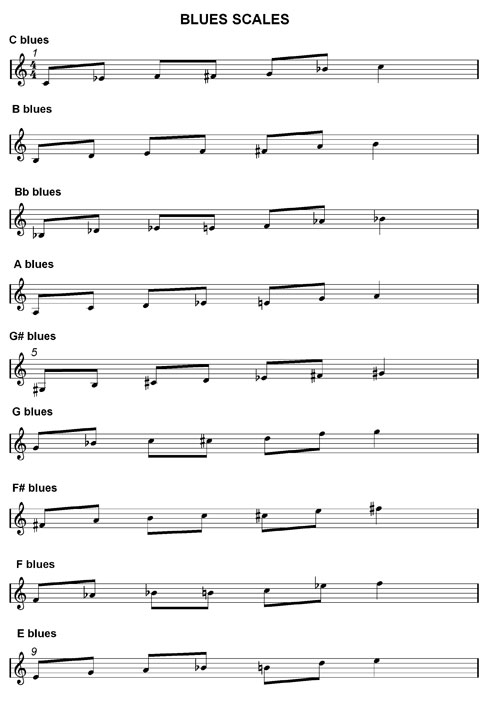Modern Jazz Piano A Study In Harmony And Improvisation Pdf To Jpg

No pianist has influenced the modern approach to jazz piano more than McCoy Tyner. From players like Chick Corea and Mulgrew Miller to non-pianists like Woody Shaw and Michael Brecker, McCoy has left his mark on generations of serious improvisers.
And one distinctive element of his approach to improvising is his creative use of the pentatonic scale.But it’s more than the five simple notes that most musicians think of using over a minor chord. As you’ll soon learn below, the pentatonic scale can add a wealth of harmonic and melodic possibilities to your solos.Take a listen to McCoy Tyners’ solo on from the album The Real McCoy. The Blues is a form that every improviser must learn and master if they want to become a proficient player. You can approach it with blues language, bebop, or even modern and outside approaches – it all comes together in the blues.And today we’re going look at 3 creative ways McCoy Tyner uses the pentatonic scale on the blues 1) Using the Minor Pentatonic Scale over Dominant ChordsIf you’ve subscribed to JazzAdvice I’m guessing you’ve learned more than a few options forAnd you probably have a few tricks up your own sleeve when it comes to creating solos over this soundHowever, one scale that many players don’t think about on V7 chords is the minor pentatonic scale. And that’s exactly what we’re going to look at today.In his solo on, McCoy Tyner uses the minor pentatonic scale over dominant chords in two specific ways: (1) from the root of the chord and (2) from the 5th of the chord.R oot of the Chord:To begin, let’s take a look at how he approaches dominant chords with a minor pentatonic scale built from the root. In the line below, McCoy uses a Bb minor pentatonic over Bb7, take a listen:Notice how this scale emphasizes the b3, b7 and 11th of the Bb7 chord in a way that is very similar to traditional blues language or the blues scale. Here’s another example that starts on the 5th note of the Bb minor pentatonic scale:5th of the Chord:The second way McCoy uses the pentatonic scale in this solo is from the 5th of the V7 chord.
Check out how he employs this technique in the line below:On both dominant chords he uses a minor pentatonic scale built on the 5th – Bb minor pentatonic over the Eb7 and an F minor pentatonic over the Bb7:But wait a second, why does this work? This scale is missing the one note that defines the harmony – the 3rd.Well, this concept goes back to the of approaching the V7 chord as the related minor ii chord, for example thinking F- over Bb7:You can also think of that static dominant chord as the related ii-V7. For example, F-7 Bb7 over Bb7. Review your minor pentatonic scales in all 12 keys. Practice the minor pentatonic scale from the root and 5th of V7 chords. Turn on a play-a-long and practice applying these scales over the dominant chords in your soloA Note on McCoy’s Left HandThe signature “McCoy Tyner sound” hinges on one thing – his left hand.McCoy’s left hand is central to the lines he plays in his right, both rhythmically and harmonically.
Those iconic 4th and 5th voicings that you hear are perfectly suited for the pentatonic and intervallic lines he plays on top.Additionally, the absence of tertian structure in his voicings allows for more harmonic freedom. Below are 3 unique aspects of McCoy’s left handThe open 5th:McCoy often plays the root and 5th of a chord in his left hand, creating a pedal point for his 4th voicings and improvised lines. If you’ve listened to the classic Coltrane Quartet or any of you’ve heard this sound:Augmented 4ths and perfect 4ths voicings:Throughout this solo McCoy voices dominant chords in stacked 4ths – either from the root of the chord or the 7th of the chord. For example, over Eb7 he will play Db, G, C and then switch to 4th’s built on the root ( Eb, Ab, Db):The tritone interval in the augmented 4th ( Db to G) creates more tension while the perfect 4ths are an open sound that don’t require resolution.Side-stepping with the left hand:One reason why McCoy has so much harmonic freedom on a simple blues is that he justifies the lines in the right hand with the voicings in his left.
Author by: John FerraraLanguange: enPublisher by: Jamey Aebersold Jazz IncorporatedFormat Available: PDF, ePub, MobiTotal Read: 25Total Download: 153File Size: 43,8 MbDescription: First, the concept of modes is discussed in detail, as well as modal harmony and composition. Their use in conventional jazz tunes as well as modal ones is explored. Next, chord scales and their application over specific chords, left hand voicings for blues, blues progression variations, and pentatonic scales are covered in detail. The chapter on pentatonics also includes inversions or positions for pentatonics, their application over specific chords, and even the use of altered pentatonics. The book then covers more advanced theory including minor harmony, dominant chord substitution, upper structure triads, voicings in fourths, diminished chord patterns and substitutes, and modulations. Numerous exercises and examples are included and performed on the accompanying CD. Excellent for the individual jazz student or classroom study, this book is applicable for all instruments.
Modern Jazz Piano A Study In Harmony And Improvisation Pdf To Jpg File
Author by: Charles AustinLanguange: enPublisher by: Lulu.comFormat Available: PDF, ePub, MobiTotal Read: 14Total Download: 706File Size: 42,7 MbDescription: 'This book is an attempt to address the techniques of piano playing as applied to the playing of jazz. It is also an attempt to address theoretical knowledge, and the application of coherent thinking when improvising jazz music.
Many aspects of preparation are outlined, including scales, chords, chord symbols, chord/scale relationships, voicings, voice-leading, and the creation of melody.' Author by: Dominic AlldisLanguange: enPublisher by: Hal Leonard CorporationFormat Available: PDF, ePub, MobiTotal Read: 16Total Download: 753File Size: 55,8 MbDescription: (Piano). A serious and thorough discussion of harmony for the literate pianist, this book by Professor Dominic Alldis of the Royal Academy of Music in London addresses accompaniment models, basic jazz theory, polychords, reharmonization, upper structure triads, block chords, pentatonic harmony, and many more subjects, drawing harmonic parallels from classical composers.
Alldis includes key excerpts from the greatest jazz standards to illustrate his points. Author by: Bill DobbinsLanguange: enPublisher by:Format Available: PDF, ePub, MobiTotal Read: 18Total Download: 589File Size: 55,9 MbDescription: This is definitely not a harmonic system for those who are looking for rules by which to write music. Rather this is an approach to unlocking the limitless harmonic possibilities which are unique to the piano. This approach can be developed in a personal manner through a lifetime without ever exhausting the creative possibilities. Of course, it is also applicable to jazz composing and arranging. The book includes hundreds of musical examples and five compositions by Bill Dobbins. Instrumentation: piano.

Author by: Tim RichardsLanguange: enPublisher by: Lulu.comFormat Available: PDF, ePub, MobiTotal Read: 64Total Download: 210File Size: 44,7 MbDescription: Scot Ranney's 'Jazz Piano Notebook' series is a collection of jazz piano books written by Scot Ranney and other jazz pianists. Volume 3 is by Tim Richards, a renown jazz pianist, composer, and author of the acclaimed 'Improvising Blues Piano' and 'Exploring Jazz Piano' series' and other books Schott Music.
'These are routines I believe are beneficial to anyone who understands the basics of jazz harmony and improvisation. I hope they throw a new slant on familiar chord sequences, or suggest new directions in your playing.' ' Tim has been a presence on the international jazz scene since the early 80s and has over a dozen albums out as a leader, featuring line-ups from duo to nine-piece. The tips and exercises in this book will help strengthen the connection between your ears and fingers to make it easier to play what you want. Level: Intermediate to advanced. Paperback binding. Author by: Noah BaermanLanguange: enPublisher by: Alfred Music PublishingFormat Available: PDF, ePub, MobiTotal Read: 72Total Download: 427File Size: 46,7 MbDescription: This comprehensive study of harmony is a must for any musician interested in jazz.

This book explains the essentials of jazz harmony in a friendly, easy-to-understand manner. A 12-key system is used to help you learn each concept in every key. Learn about rootless voicings, shell voicings, spread voicings, clusters, and how to select which voicings to use. Other topics include ii-V-I progressions, dominant chord cycles, 'Rhythm Changes,' Giant Steps substitutions, thinking in modes, non-diatonic progressions and much more.
Author by: Bob MintzerLanguange: enPublisher by: Alfred MusicFormat Available: PDF, ePub, MobiTotal Read: 77Total Download: 992File Size: 43,5 MbDescription: For an aspiring jazz instrumentalist, playing piano is one of the most important skills for developing a jazz vocabulary. Bob Mintzer is a renowned jazz composer, arranger, saxophonist, pianist, bandleader, educator and member of the group, the Yellowjackets. His new book is designed for the instrumentalist who is not an accomplished piano player but wants to acquire basic jazz piano skills and jazz vocabulary. The book includes etudes that make players aware of the sound, texture, cause, effect and function of jazz chords and harmony. The 22 piano etudes feature a variety of styles, tempos, chord progressions and a the book also includes a chord voicing glossary. Mintzer offers a practical guide with a realistic approach.